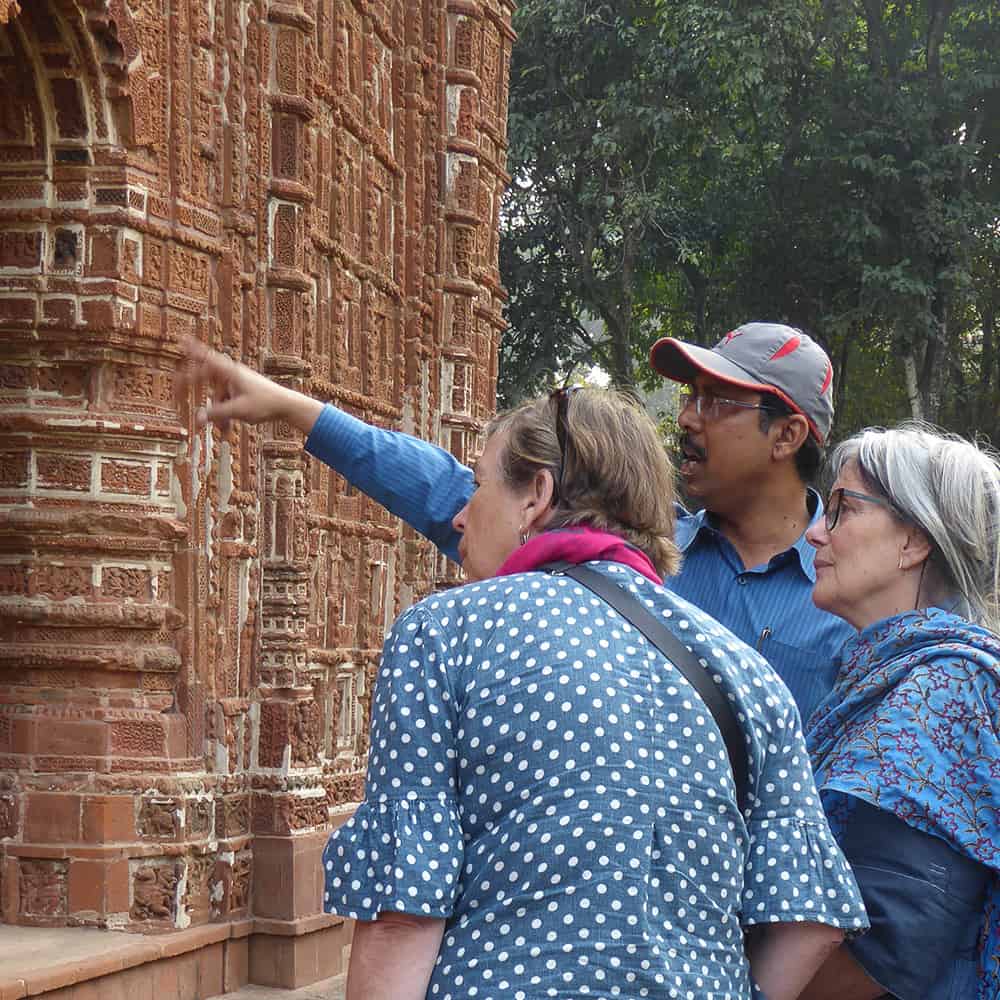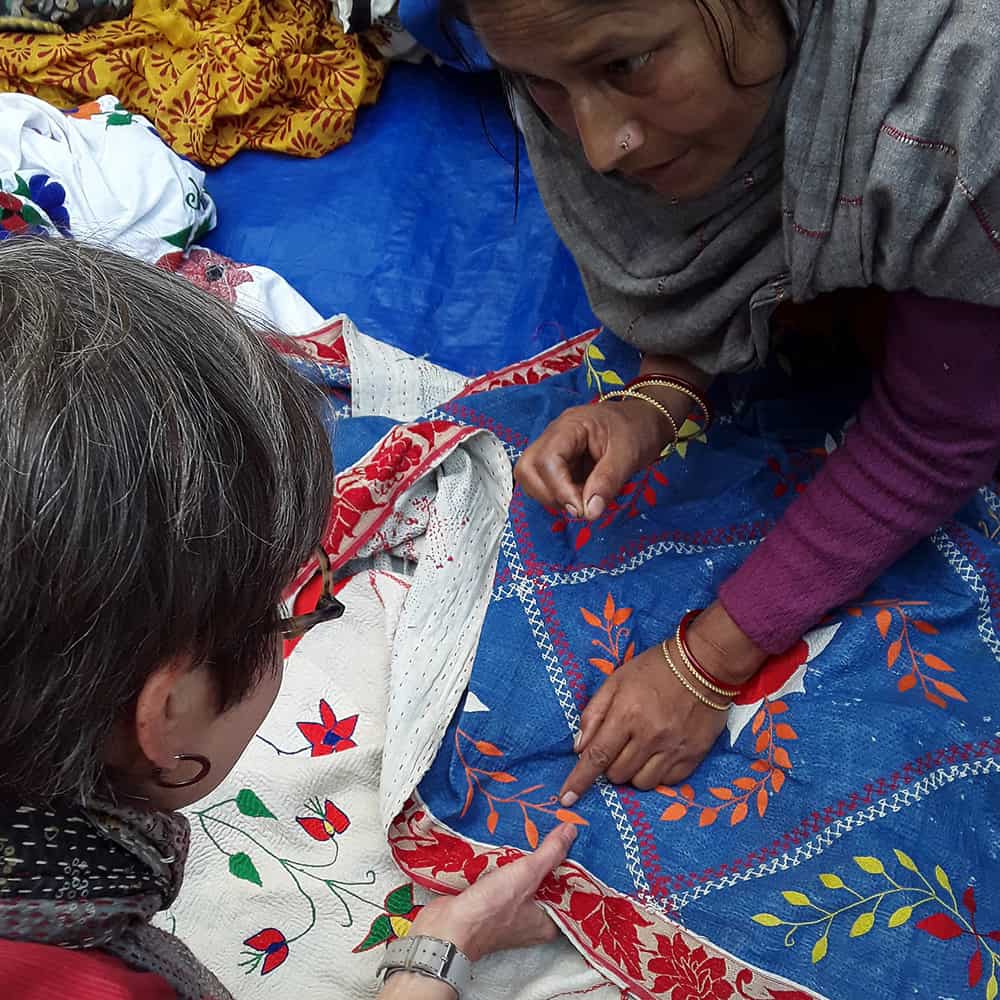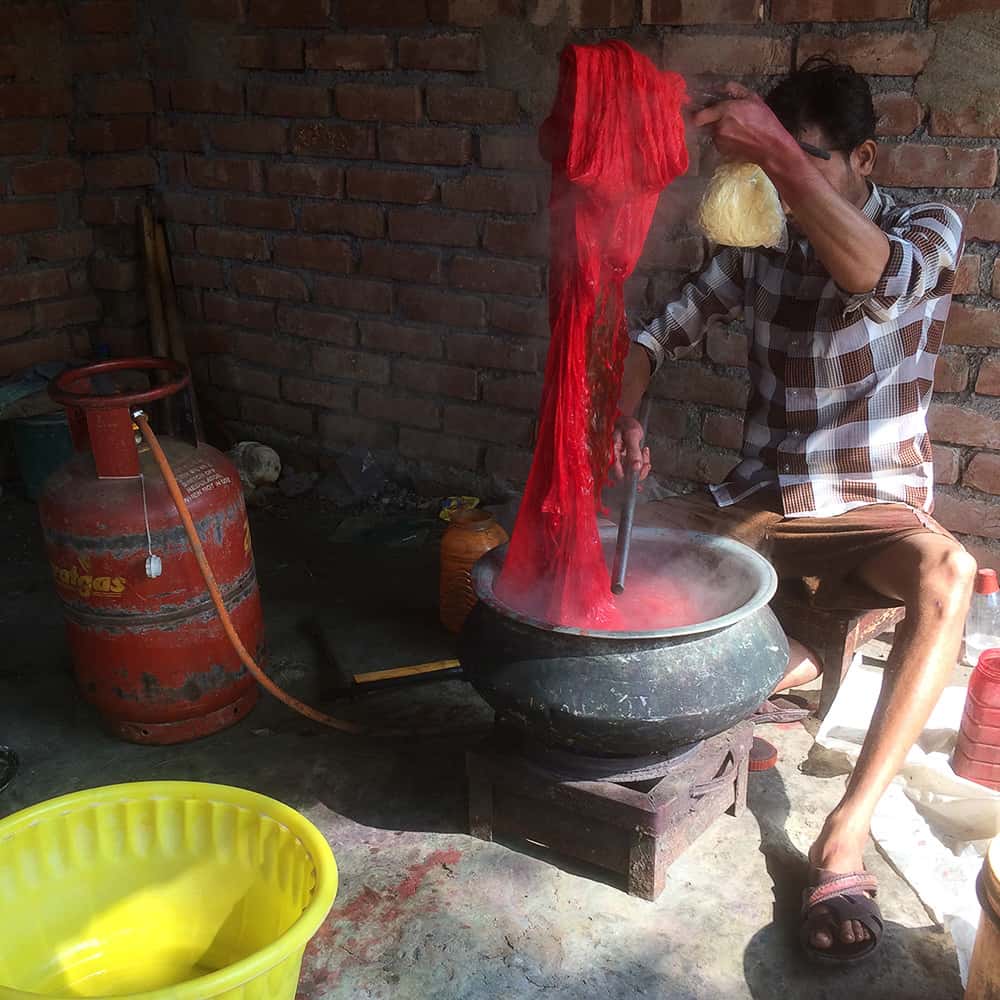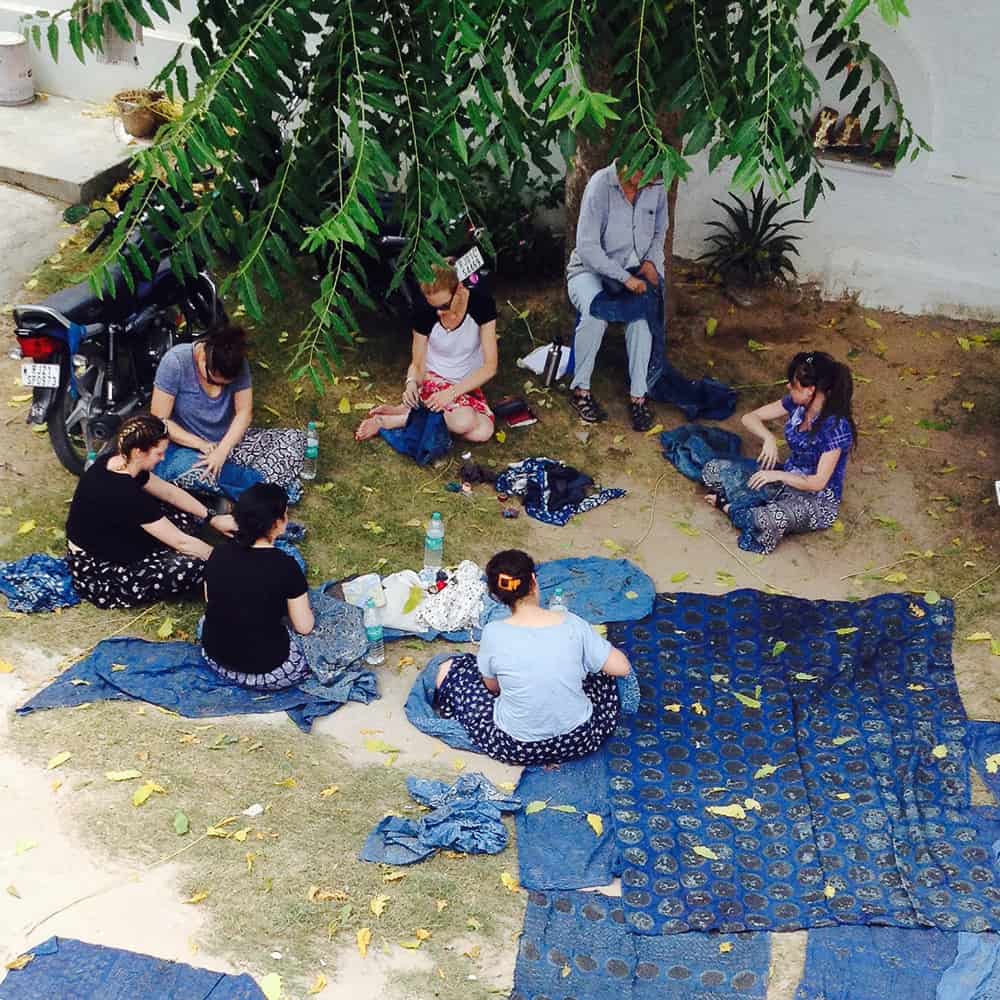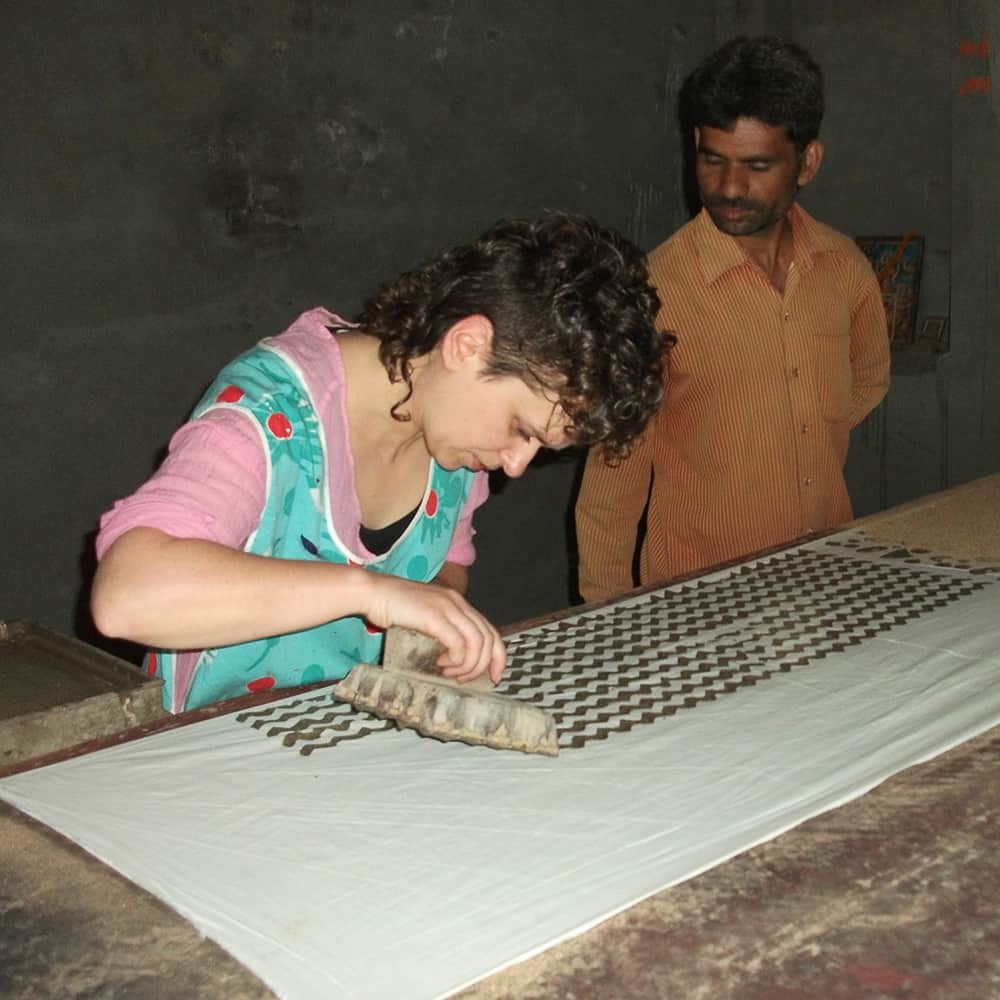- Suvendu Mukerjee telling the story of Lord Krisha depicted in ceramic tiles – Bishnupur. Photo Julia Raath
- Sharing a conversation about Kantha embroidery – Shantiniketan West Bengal 2019. Photo Julia Raath
- Sharing stories with people we meet Kalna River Crossing West Bengal 2019 Photo Julia Raath
- Silk Dyer, West Bengal Photo Julia Raath
- Study tour 2015. Working on Dabu and indigo prints in the courtyard of the Stitching Project – Puskar Photo Julia Raath
- Ana Petidis learning Dabu Printing, 2015 Photo Julia Raath
- Learning about the fine touch required when plying yarns – Berampore West Bengal. Photo Julia Raath
My first trip to India was to attend a fashion and textiles conference. I had always been a little afraid of going to India. It was a mysterious place, and despite reading the various guides I didn’t really know what to expect, how to get around, how I would respond to the poverty, and not whether I would get sick, but how sick I would get. But I had always been curious about textiles both traditional and large scale industrial. For me, India had it all. It was worth the risk.
I had the best introduction. I was met at the airport by a driver who took me wherever I wanted to go. A young design student was by my side for the three days of the conference to make sure the things I needed were provided and to answer all my questions.
After the conference, we were taken to a menswear factory on the outskirts of Delhi. I had imagined a dark awful place with lines of machinists working in poor conditions but instead, we saw state of the art facilities. Clean, organised, a well-lit workshop and large signage spelling out regulations about abiding with environmental and child labour legislation.
I also visited the marketplace at Lajpat Nagar where I found textile dyers set up in the market. I sat and watched the customers hand over white cotton and rayon dupatta and pieces of coloured fabric, offcuts from garment they were having tailored.
I was mesmerised by the speed and the accuracy of colour matching—not a set of scales in sight but bubbling pots of water into which the dyers would spoon small quantities of different powdered dyes. Then a flicking of the fabric to remove all the water so it would dry quickly and be ready for the customer to pick up a few hours later. A perfect result every time.
But this was not all there was in the marketplace. Every type of textile was there, complex patterned silk brocades from Varanasi, Pashmina woollen shawls from Kashmir, tiny knotted Bandhani scarves and embroideries from Gujarat, fine cotton muslin Jamdhani from West Bengal and more. I could not only touch them and inspect the detail but there were literally hundreds and hundreds of different designs and colour combinations.
I met people from all over India and made great friends. It was a great introduction, challenged my preconceptions of this diverse nation and buffered me from all the challenges India throws at you.
This guided introduction gave me the confidence to venture back to India again and again.
As a teacher of textiles, I was in heaven. Until then, my exposure to traditional textiles had been mostly through books, visits to galleries and museums or the collections belonging to friends and colleagues or the poorer quality textile products being sold in the hippy shops in Sydney.
I wanted to meet the makers, the artisans who were responsible for these exquisite textiles.
I have since been to India more than a dozen times. I have met many artisans.
That first trip provided me with the model to introduce people to India, to expose them to its rich traditions and diverse culture, through textiles and through food.
I led my first guided tour while still a teacher. In 2015 I received funding through the VET Outbound Mobility Program to take a group of 15 students. The tour was quickly named the OMG (Oh My God) tour— the exclamation that came out of the mouths of the students at every place we visited. We toured a large industrial textile factory producing printed and woven for American and European market; we did a 24-hour design challenge with textile students from the National Institute of Fashion Technology in Delhi and we got to try our hands at creating printed textiles.
Fiona Wright and Praveen Nayak from the Stitching Project and Creative Arts Safaris arranged to have students designs carved by a Master Block Carver, Mr Renu Khan in Bagru where we also learnt Dabu, mud resist block printing. We then spent three days at the Stitching Project workshop in Pushkar where students did more printing, natural dyeing and embroidery. And in between, we enjoyed a variety of great Indian food. It was life-changing. These opportunities, and to be exposed to this variety of textile practices does not exist in Australia.
I am no longer a full-time teacher, but I still lead tours through my company Surfaced once a year with a focus on textiles and crafts in West Bengal. I work closely my local guide and interpreter Suvendu who accompanies us. Suvendu is a Bengali who has an excellent local knowledge, a great sense of humour—and he is very patient.
Participants do workshops in block printing, Kantha embroidery, and a natural dyes. We travel to Murshidabad, Shantiniketan and Bishnupur to learn more about village crafts including fine silk and cotton weaving, leathercraft, lost wax metal casting, and ceramic sculptures. We meet the people who make the work. We visit the markets and are exposed to new fruits and vegetables and learn why Bengali food is different from other Indian cuisines. We connect across language, people, culture and craft
I do it because I love being in India. I take the tours because I want to share my passion and enthusiasm for the country, their crafts and textiles but most of all the people we meet. There is something about India. It gets under your skin. It is not an easy country to travel in—it can be very challenging, there are so many things you need to be aware of, such as diet, water, dogs, traffic, noise and trip hazards. But when I am there, I feel alive, alert and excited and the challenges pale in comparison to the delights. I have made great friends and have found people to open, warm and generous. It gives me great pleasure to share my experiences and to provide a supported introduction to this intriguing country.
Author
 Julia Raath lives in Melbourne, Australia, and offers small group tours to India, works with the Angel Women’s Self Help Group in Tamil Nadu who make baskets, designs and prints textiles, teaches print workshops and enjoys a full life. See www.surfaced.com.au.
Julia Raath lives in Melbourne, Australia, and offers small group tours to India, works with the Angel Women’s Self Help Group in Tamil Nadu who make baskets, designs and prints textiles, teaches print workshops and enjoys a full life. See www.surfaced.com.au.

